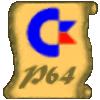Turbo232 Programming.txt
From ReplayResources
Revision as of 21:22, 15 June 2010 by Count Zero (talk | contribs) (Created page with ''''Turbo232 Programming''' Text included from [http://ftp.giga.or.at/pub/c64/library/turboprg.txt turboprg.txt] at http://ftp.giga.or.at Category:RS-232_Interfaces ---- …')
Turbo232 Programming
Text included from turboprg.txt at http://ftp.giga.or.at
Turbo232 Programming
Revision T v1.0.0
This document outlines the differences between SwiftLink and the
Turbo232 cartridges. It assumes that the programming has knowledge of or
separate information concerning programming SwiftLink.
GENERAL
The Tubro232 cartridge is functionally compatible with the operation of
the original SwiftLink models designed by Dr. Evil Labs. However, the
new version shares only the 6551 ACIA in common with the original
designs, and has been completely redesigned to meet the goals of
extending the capabilities of this product while maintaining functional
compatibility.
Three new speeds have been added (57.6Kbps, 115.2Kbps and 230.4Kbps)
via an additional register which controls a programmable clock. In
addition, the external IRQ/NMI switch has been discontinued, though this
functionality is still available via an internal jumper block, which
also allows for changes to the DSR configuration and default I/O
address.
Finally, the effect of 'mirroring' of registers throughout the I/O
page has been reduced to 32 bytes, so that the product can be used
without interference with GEORAM and similar devices. CMD can also
provide custom programmed versions of the decoding chip used in the new
product to change the base address to any 32-byte boundry within the
selected I/O page; this latter provision is targeted at programmers who
wish to create applications which use multiple Turbo232 cartridges
within the same I/O page, as well as to users of such applications if
and when they exist.
DETAILS
It is first important to note the different memory 'footprint' of the
Turbo232. While SwiftLink contained only 4 registers whose contents were
mirrored at every 4 memory locations throughout the I/O page occupied by
the device, Turbo232 maps 8 register locations which are mirrored for
only for 32 bytes from the base address. Of the four new register
locations, only one is actually implemented: the ES (Enhanced Speed)
register, located at an offset of $07 from the base address.
For baud rates up to and including 38.4Kbps, Turbo232 is programmed
just like a SwiftLink. The only possible cause for incompatibility that
may be noted is the difference in mirroring of registers which might be
used by some programs to detect the presence of a SwiftLink. It is this
very difference, however, that will allow the programmer to determine
whether a SwiftLink or a Turbo232 is installed (see "DETECTION
ROUTINE").
To obtain the new high-speed baud rates, you must first set the
lowest four bits of the register located at offset $03 to zero (the
upper 4 bits are insignificant). [Note: Setting these bits to zero will
result in a value of 1 in the mode bit (bit 2) of the ES register.] You
may then set the specific high-speed baud rate using bits 0 and 1 of the
ES register. Since bit 2 of the ES register (mode bit) is read-only, and
bits 3 through 7 are insignificant, you can safely program the rate by
storing in that location a value of $00 for 230.4Kbps, $01 for
115.2Kbps, or $02 for 57.6Kbps. [Note: Storing a value of $03 to the DS
register isn't recommended, though it isn't harmful; it provides no
clock output, but remains reserved for future expansion.]
REGISTER INFO
$Dx00 DATA REGISTER Same as original SwiftLink
$Dx01 STATUS REGISTER Same as original SwiftLink
$Dx02 COMMAND REGISTER Same as original SwiftLink
$Dx03 CONTROL REGISTER Same as original SwiftLink, plus
xxxx0000 sets enhanced-speed mode
$Dx04 UNDEFINED
$Dx05 UNDEFINED
$Dx06 UNDEFINED
$Dx07 ES REGISTER 7 6 5 4 3 2 1 0
x x x x x M S1 S0
M (bit 2) Mode (read-only)
0 = Normal SL mode
1 = Enhanced Speed mode
S1, S0 (bit 1 and bit 0) Speed
(read-only if M=0)
00 = 230,400 bps
01 = 115,200 bps
10 = 57,600 bps
11 = undefined, no clock output
reserved for future expansion
DETECTION ROUTINE
The following can be used to determine if an installed SwiftLink is the
standard or Enhanced Speed type:
LDA #$00
STA $Dx03
LDA $Dx07
After executing this code, the A register will contain a zero if a
standard SwiftLink is installed, but will be non-zero if a Turbo232 is
installed.












